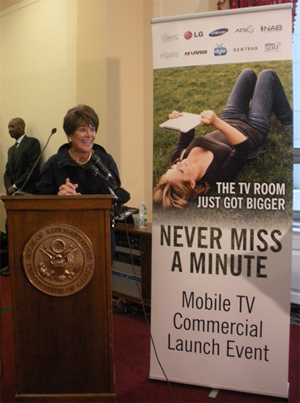House Members: Mobile DTV Could Be Data Cap Video Solution

Broadcasters celebrated the ceremonial launch of mobile DTV
at a Capitol Hill kick-off event Thursday complete with legislators praising
broadcasters newly-minted mobility and pointing out that mobile DTV could be a
way for wireless customers to avoid data caps by viewing video over mobile broadcast
rather than using their wireless data plans.
There was actually no official launch -- mobile DTV is
already up and running on 130 stations in 50 markets, with more coming online
in the fall - but was instead a way to let Capitol Hill know, before Congress
exits at the end of this week that there was a mobile video service up and
running that provided news, sports, entertainment and life-saving info without straining
data plans or pocketbooks.
MetroPCS earlier this year became the first wireless carrier
to carry mobile DTV service, via a mobile DTV-enable Samsung Galaxy phone that
hit the market last month and delivers Mobile Content Venture's Dyle mobile TV service.
A standing-room-only crowd -- there were actually no chairs,
but the room was packed nonetheless -- heard from a series of House
Communications Subcommittee members who praised mobile DTV as an American
success story and a way for broadcasters to secure their future, something
broadcasters have been arguing as the FCC encourages them to move over and make
way for wireless broadband.
While the room was dominated by an elephant -- it was
actually a costumed Babar character courtesy of Qubo, the kids net available
from mobile DTV pioneer Ion -- it was
Democrats who dominated the lectern to praise the new service.
Rep. Anna Eshoo (D-Calif.) called the day a
"celebration of American innovation." She said that given studies
that show 70% of video watchers want to access it on a screen other than a TV,
broadcasters were smart to come up with a service that would not use up
wireless subscribers' capped data plans. Usage-based wireless plans and their
effect on video consumption has been the subject of scrutiny in Washington,
including an ongoingJustice Department investigation. Downloading/streaming video is both a
popular and a bandwidth-hungry use of smartphones and tablets.
She said broadcasters were to be saluted for looking ahead
and "leap-frogging into the future."
Broadcasting & Cable Newsletter
The smarter way to stay on top of broadcasting and cable industry. Sign up below
Rep. Ed Markey (D-Mass.), the longest serving member of the
Communications Subcommittee said the key words were "free," "mobile"
and it "doesn't need more spectrum." In addition, he said, it is a
"done deal." Markey joked that with the addition of mobile DTV,
broadcasters were ensuring that nobody ever looks up or makes human contact.
But he was serious when he said that that broadcasting "has always been at
the center of communications in our society" and that mobile DTV was
harnessing the power of broadcasting as the world went mobile. He said mobile
would be the key for broadcasting to "thrive and succeed in the 21st
century."
Adding his voice to the chorus of praise was Rep. John
Dingell (D-Mich.), who has long been a strong supporter of broadcasting. He
said it had been wise for broadcasters to go mobile and echoed Eshoo by
pointing out that consumers could see their favorite shows without "depleting
their monthly data allowance."
While broadcasters have long been arguing that
broadcasting's one-to-many architecture could help offload bandwidth-hungry
video and other data from wireless networks during peak periods, the
legislator's invocation of data caps put that benefit in a different and
politically powerful light. The point drew applause from a crowd that included
members of various mobile DTV interests, including execs from Fisher, LIN and
Hearst.
Republican Cliff Stearns (R-Fla.), who lost his primary run
and so will be exiting at the end of this Congress, praised the
"one-to-many" broadcast architecture, but also brought up his support
of TV station online political file posting and spectrum reclamation, which
were not likely to be applause lines for broadcasters, and weren't.
While mobile DTV is not new, new products for the service
being introduced to the market over the next three months include a mobile RCA
7-inch TV (about $230) and an iPad adaptor.
Currently the Samsung Galaxy S LightRay 4G is the only
mobile DTV-enabled phone, available through MetroPCS. Since MetroPCS does not
bundle the phone with a contract and thus subsidize the price of the phone,
consumers have to pay the full price of about $450.
The event's hosts included Dyle, the Mobile 500 Alliance and the
Open Mobile Video Coalition, which together represent more than 1,300 TV
stations.
Contributing editor John Eggerton has been an editor and/or writer on media regulation, legislation and policy for over four decades, including covering the FCC, FTC, Congress, the major media trade associations, and the federal courts. In addition to Multichannel News and Broadcasting + Cable, his work has appeared in Radio World, TV Technology, TV Fax, This Week in Consumer Electronics, Variety and the Encyclopedia Britannica.

